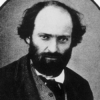Paul Cezanne

Paul Cezanne
Paul Cézannewas a French artist and Post-Impressionist painter whose work laid the foundations of the transition from the 19th-century conception of artistic endeavour to a new and radically different world of art in the 20th century. Cézanne's often repetitive, exploratory brushstrokes are highly characteristic and clearly recognizable. He used planes of colour and small brushstrokes that build up to form complex fields. The paintings convey Cézanne's intense study of his subjects...
NationalityFrench
ProfessionPainter
Date of Birth19 January 1839
CityAix-en-Provence, France
CountryFrance
Here on the edge of the river, the motifs are very plentiful, the same subject seen from a different angle gives a subject for study of the highest interest and so varied that I think I could be occupied for months without changing my place, simply bending a little more to the right or left.
Under this fine rain I breathe in the innocence of the world. I feel coloured by the nuances of infinity. At this moment I am one with my picture. We are an iridescent chaos...
One is neither too scrupulous nor too sincere nor too submissive to nature; but one is more or less master of one's model, and, above all, of the means of expression.
Get to the heart of what is before you and continue to express yourself as logically as possible.
The strong experience of nature... is the necessary basis for all conception of art on which rests the grandeur and beauty of all future work.
I am still searching for the expression of those confused sensations that we bring with us at birth.
One must see one's model correctly and experience it in the right way; and furthermore express oneself forcibly and with distinction.
See how the light tenderly love the apricots, it takes them over completely, enters into their pulp, light them from all sides! But it is miserly with the peaches and light only one side of them.
Personally I would like to have pupils, a studio, pass on my love to them, work with them, without teaching them anything.. ..A convent, a monastery, a phalanstery of painting where one could train together.. ..but no programme, no instruction in painting.. ..drawing is still alright, it doesn't count, but painting - the way to learn is to look at the masters, above all at nature, and to watch other people painting..
Yes, a bunch of carrots, observed directly, painted simply in the personal way one sees it, worth more than the Ecole's everlasting slices of buttered bread, that tobacco-juice painting, slavishly done by the book? The day is coming when a single original carrot will give birth to a revolution.
I allow no one to touch me.
Keep good company - that is, go to the Louvre.
I must be more sensible and realize that at my age, illusions are hardly permitted and they will always destroy me.
An art which isn't based on feeling isn't an art at all.